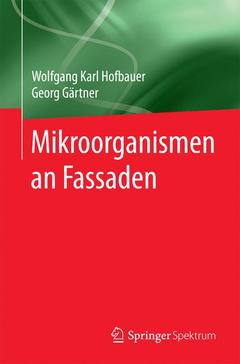Description
Microbial life on Façades, 1st ed. 2021
Authors: Hofbauer Wolfgang Karl, Gärtner Georg
Language: German
Subjects for Microbial life on Façades:
Keywords
Fassaden; Gebäude; Algen; Pilze; Mikroorganismen; Schimmel; Systematic Botany
Approximative price 105.49 €
In Print (Delivery period: 15 days).
Add to cart323 p. · 16.8x24 cm · Paperback
Description
/li>Contents
/li>Biography
/li>Comment
/li>
This book provides a detailed overview of the microorganisms that form the initial growth on the exterior façades of buildings. It deals with the ecophysiological properties that characterize the basic conditions under which these microorganisms can occur on façades. In addition to an identification key for the types and forms of microorganisms, this book provides a detailed description of the individual organisms, stating their ecological range. Furthermore, the various ecological parameters are discussed in short chapters. Measures to prevent and combat the colonization of façades with microorganisms are also addressed.
Specialists (architects, construction experts), builders, scientists and master students can find all the information they need on facade algae and fungi here.
Introduction: Façades colonized by aerophytic microorganisms.- Façades as a functional part of a building.- The environment façade.- History of aerobiology, in respect of research on man-made surfaces.- Tools/Methods.- Experimental investigations and the assessment of primary growth of microorganisms on modern buiding structures.- Assessment of starter germ load of materials. Germ counts for specimens.- Culture based taxonomic analysis.- Taxonomy.- Pre-culture investigation.- Sample collection and preparation.- Establishment of pure cultures.- Background concentrations.- Air germ measurement.- Sedimentation.- Germ load of precipitation.- Ecophysiologic data.- Testing methods in respect of ths susceptibility of building products against colonisation by microorganisms.- Aerophytic organisms colonizing façades: their diversity and taxonomy with recognition of ecophysiological characteristics.- Regnum Eubacteria – non oxygen phosynthetic active groups.- Regnum Archaea.- Division Rhodophyta – Class Rhodophyceae.- Division Stramenopiles (Heterokonta), Class Bacillariophyceae.- Division Stramenopiles (Heterokonta), Class Xanthophyceae.- Division Stramenopiles (Heterokonta), Class Eustigmatophyceae.- Division (Infraregnum) Chlorophyta, Class Chlorophyceae.- Division (Infraregnum) Streptophyta.- Class Bryopsida – Musci.- Class Pteridopsida.- Subregnum Eumycota.- Division Archemycota.- Class Zygomycetes.- Division Ascomycota.- Class Ascomycetes.- Division Basidiomycota.- Class Basidiomycetes.- Form of organisation Lichenes.- Formgroup Ascolichenes.- Synopsis.- Summary.- Acknowledgements.- Glossary 1.- Glossary 2 (important technical terms).- Literature
Dr. Wolfgang Karl Hofbauer is chief scientist (taxonomy, ecophysiology and genetics) of the department Environment, Sensors and Hygiene at the Fraunhofer Institute for Building Physics. His professional research areas are taxonomy and ecophysiology of organisms on building surfaces, about which he did his doctorate in 2008, genetic barcoding of building relevant (micro)organisms and greening of building surfaces.
Retired Prof. Dr. Dr.h.c Georg Gärtner worked and researched at the University of Innsbruck on the cultivation and taxonomy of soil-and airborne. algae for many years. In 2012, Prof. Gärtner was awarded an honorary doctorate by Sofia University for his services to the cooperation in algal studies between the botanical institutes of the University of Innsbruck and the University of Sofia.
Offers a unique overview of microorganisms on façades
Contains an identification key for easy identification of the species
Illustrates the contents with numerous figures
Treats the ecophysiology of microorganisms in detail
Describes measures for prevention and control of colonization of façades




